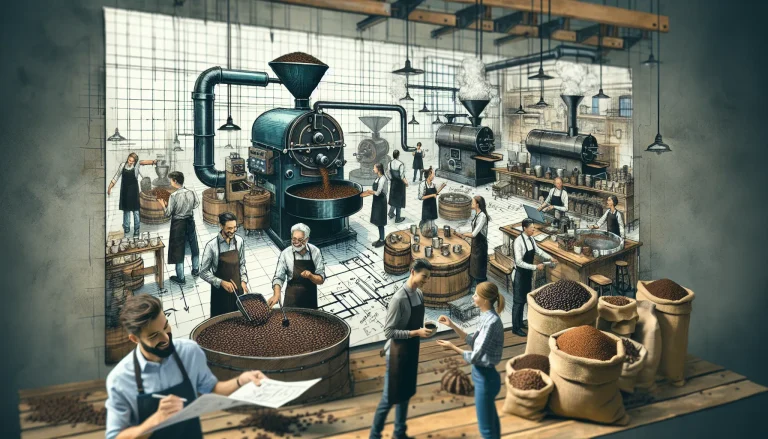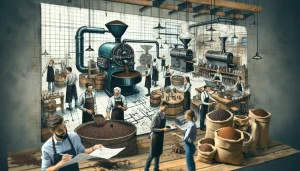In the vast landscape of coffee businesses, crafting a solid roaster business plan is not just any old option, it’s your survival kit. Ever looked at the daily consumption stats?
Over 2.25 billion cups of coffee devoured around the globe every day. That's nearly enough to fill 900 Olympic swimming pools with steaming mocha delight!
Yet, amidst this behemoth consumer demand, many coffee roaster operations still teeter and totter. Not because they lack an inviting aroma, but largely from an absence of a tailored, strategic business plan.
“What is a good coffee roaster business plan?” If that question has been gnawing at your consciousness, then buckle up. This post is set to serve you the nitty-gritty essentials of creating the near-perfect plan— the proverbial ‘shot of espresso’ in outsmarting your competition. It’s time to truly brew success with your coffee roaster business.
America's Coffee Craze ☕️

Metrobi drivers are rated 4.97 out of 5
Trusted by local businesses for:
- Background-checked professionals
- Specialized in business deliveries
- Same drivers for consistency
- 4.97/5 average delivery rating
The Blueprint to a Successful Coffee Roaster Business Plan
Step 1: Understanding the Coffee Roasting Market
Coffee roasting is more than an art; it’s a booming industry. You’re not just dabbling in coffee beans and their aroma; you’re diving into a multi-billion-dollar industry inhabited by countless competitors. Can you carve out your niche in this bustling market? To do so, a clear comprehension of the coffee roasting market becomes paramount. At Metrobi, we specialize in optimizing coffee logistics and distribution, ensuring your unique blends reach their destinations efficiently and reliably.
For starters, get to know your customers. They come in all forms – cafe owners, retail customers, wholesalers. Each has unique tastes, preferences, and price points. Thinking about launching your cafe? Dive into a cafe business strategy template and good examples to begin your journey on the right foot.
Understanding competitors is equally crucial in this landscape. Identify the major players, what they do well, and where they falter. This doesn’t imply launching into a copycat strategy but acquiring cues to stand out.
Pay attention to trends too. The coffee market, like many others, is influenced by global and local trends. For instance, single-origin coffee has seen a surge in demand due to discerning customers. Are there similar opportunities to capitalize on?
Coffee and Health 🌿
48% of people agree that drinking coffee benefits their health.
Step 2: Identifying Your Unique Selling Proposition
Once you’ve got a handle on the market, it’s time to distinguish your coffee. What sets your roasts apart? Perhaps it’s the beans, the roasting process, or your commitment to sustainability. Whatever it might be, this unique selling proposition (USP) adds an irreplaceable dimension to your brand.
Manifest this USP into everything you do – from your packaging to your marketing. A potent USP can be a game-changer that turns coffee connoisseurs into loyal customers. More than enthralling your customers, it can make competition irrelevant, allowing your business to break away from the rest.
Coffee Shop Loyalty ☕
51% of people purchase coffee from a coffee shop at least once a week.
Step 3: Creating a Comprehensive Business Model
Regardless of your business type, a comprehensive business model is the backbone of your enterprise. With your USP identified, it’s time to sketch out how you’ll sell, distribute, and market your coffee, and who to. Are you primarily targeting cafés or end consumers? Will you adopt a brick-and-mortar, e-commerce, or mix of both models?
Answering these questions will streamline your operational strategy. Additionally, it will help outline revenue sources, expenses, and your pricing strategy. An extensive business model mitigates unforeseen challenges and preempts strategies for growth and expansion.
To ensure your coffee roastery business succeeds, it’s crucial to incorporate detailed business planning, including thorough market research and a clear understanding of coffee costs.
A comprehensive business plan should cover all key elements: an executive summary highlighting your aim to produce high-quality coffee; a marketing plan outlining strategies to reach your targeted customer segments; profit and loss statements to forecast financials; considerations for sales tax as your business grows; and operational plans for using commercial roasters.
This foundational document guides every decision as a business owner, from choosing between being a coffee roaster wholesaler or focusing on direct sales, to determining the right marketing approach for your unique coffee roasteries.

Metrobi is transforming coffee deliveries
Specialized solutions for coffee businesses:
- Coffee-trained drivers
- Proper handling equipment
- Peak day delivery support
- 23% average cost reduction
Why Most Coffee Roaster Businesses Fail
Lack of Market Understanding
One of the main reasons for the failure of numerous coffee roaster businesses is the inability to grasp the market intricacies they are attempting to participate in. The coffee market is not limited to brewing; it involves dealing with coffee growers, understanding the complex chain from farm to cup, grasping coffee species and varietals, and keeping pace with ever-evolving consumer preferences.
Multiple Cups a Day 🍵
36% of people drink 3 to 5 cups of coffee a day.
Inadequate Business Planning
Another common failure point is poor planning. Many kickstart a coffee roasting business based solely on passion and limited hands-on experience, neglecting the essentials like a solid business plan, realistic budget, and crucial timelines.
Without a comprehensive plan, it’s challenging to ascertain the right roasting equipment, understand inventory needs, identify potential clientele, project sales, calculate overhead costs, and forecast profitability. Ambiguity in these areas can lead to a disaster. To help mitigate some of these challenges, leveraging efficient logistics can play a crucial role. For instance, utilizing a Seattle same-day delivery service can streamline your operations and ensure your product reaches your customers without unnecessary delays, which can be especially critical in the coffee business where freshness matters.
Poor Financial Management
The inadvertent financial management surfaces as another key failure reason. The operational costs of a coffee roasting business can accumulate quickly, from procuring high-quality beans and installing the right roasting and packaging equipment, to managing inventory, rent, utilities, and staff salaries.
It’s also crucial to budget for marketing initiatives, potential downturns, regulatory compliance, and unexpected expenses. Moreover, one must decipher the nuances of pricing the product rightly to ensure profitability without scaring away potential consumers. Overlooking these elements can lead to a financial crisis, hampering business growth.
Brewing Up Growth ☕️
The global Coffee Roasters market is projected to grow at a 7.1% compound annual growth rate (CAGR) between 2023 and 2030, with a market worth of USD 1.93 billion in 2022.
Understanding Profit Margins in a Coffee Roasting Business
Revenue Streams in a Coffee Roasting Business
The backbone of your coffee roasting business is the revenue streams you choose to tap into. There’s no single solution – success comes from a blend of multiple approaches.
Different ways to generate income
Consider the obvious methods: selling raw beans direct to consumers, supplying local cafes, or even providing bespoke roasting services. More industrious roasters might move into offering barista training or collaborating with artisan bakeries to create coffee-infused goods.
A successful blend of revenue streams pays attention to market demand and customer preferences. Regularly assess what’s contributing the most to your bottom line, testing new products and services to find what resonates with your target market.
Maximizing profitability
Don’t confuse activity with profitability. It’s easy to get caught up in the buzz of new offers, but the key is to scrutinize each venture for its potential return on investment. Every initiative should add significant revenue potential or drive customer loyalty to justify its existence. In short, if it doesn’t make money, it doesn’t make sense.
Cost Analysis
No business runs cost-free. A thorough understanding of your ongoing costs is crucial to securing your profit margins.
Breakdown of common costs in a coffee roasting business
Running a coffee roasting business takes more than a roaster. You need high-quality beans, packaging, shipping infrastructure, premises, and, of course, a diligent team. Each aspect contributes to your overheads, meaning you have to continue bringing in sufficient revenue to meet these costs – and, ideally, go beyond them.
Always keep an eye on your balance sheet. Recognise the impact of your major costs. Rent, wages, the price of raw materials – these, among other things, dictate your break-even point and profit potential. Understand their individual impact with deep dive analytics, tracking the ebbs and flows of each cost component.
Strategies for managing and reducing costs
Efficiency is king in a coffee roasting operation. While you can’t avoid costs, you can certainly strive to manage them.
Monitor and investigate any significant cost increases. Review supplier contracts regularly to ensure the best price and seek to optimise your internal operations. Aim for a lean and efficient setup – remember, every dollar saved is an additional dollar of profit.
But remember – cost-cutting should never sacrifice the quality of your product or service. Securing your reputation for quality is paramount to long-term success. In the end, maintaining quality might be the most significant strategy for managing costs in the long run, by fostering customer loyalty and repeat business.
This understanding of revenue streams and cost structures creates a clear framework for profitability potential of a coffee roasting business. Armed with this knowledge, you can take steps to secure and grow your profit margins.
Leading Roasting Technique 🔥
The largest segment in the Coffee Roasters market is the Semi-direct Fire with Half Hot Air Style, holding a share over 65%.
What is a Coffee Roaster Business?
The Role of a Coffee Roaster
The food-service universe holds companies of all sizes, from multinational giants to single-person operations. In the realm of coffee, a coffee roaster business is a principal player, working behind the scenes to shape the flavor profiles of the coffee that we savor daily. As roasters, these businesses are the guardians of quality, the alchemists transforming green seeds into aromatic brown beans that excite the senses of coffee lovers worldwide.
Coffee roasters are the bridge between the coffee farm and your morning cup, responsible for bringing out the best flavors from the quality raw material. Roasters partner closely with coffee growers, purchasing raw green coffee beans which they then carefully roast to bring out varied flavors and characteristics. The connection between roasters and growers is indispensable, contributing to the traceability and sustainability of our coffee supply.
The Process of Coffee Roasting
Coffee roasting is an art as much as it is a science. It is a complex process involving several principles from chemistry and thermodynamics and requires precision and skill to master.
In essence, coffee roasting is the process of heating green coffee beans in a coffee roaster to transform them into roasted coffee products. The roasting process is what produces the characteristic flavor of coffee by causing the beans to change in taste.
The beans are kept moving throughout the entire process to keep them from burning. As they are roasted, they’ll first turn a yellowish color and the beans will begin to smell grassy. The beans then darken to a light brown and will begin to smell like coffee. After the first crack, the roast can be considered complete at any time according to taste. The further the beans are roasted, the more they lose the inherent tastes of their origins and take on flavor from the roasting process.
Just as winemaking can be broken down into grape-growing and wine-producing, so too coffee can be viewed in two stages: coffee farming and coffee roasting.
Why Start a Coffee Roaster Business?
If you’re flirting with the idea of launching a business, why not consider diving into the coffee world, more specifically, running a coffee roasting business? Pull up your sleeves. Let’s get into the heat of it.
The Growing Demand for Specialty Coffee Industry
Drinking coffee has morphed from a simple morning routine to an intricate experience savored by passionate java enthusiasts. It’s coffee time, and it’s not just about any coffee, but more about pursuing unique, ethical, and skilfully brewed cups – the birth of the specialty coffee market.
While large franchises like Starbucks dominated the industry in the past, today, committed coffee lovers are seeking out local, artisanal roasters who offer unique experiences and flavors. This growing preference for quality over convenience is blowing the doors wide open for specialty coffee roasters. With Metrobi, these businesses can extend their reach, as we offer delivery services across more than 20 U.S. cities, including Denver, ensuring that even the most distinctive coffee flavors find their way to enthusiasts everywhere.
Not only is the demand for specialty beverages on the rise, but the demographics of coffee drinkers are also broadening. Millennials are driving the increase in coffee consumption, with most willing to pay a premium for high-quality brews.
Equally important is the shift towards ethically sourced coffee. Consumers are increasingly concerned about the ethics behind their cups. They are aware that by purchasing from small-scale, local, and ethical roasters, they are supporting sustainable coffee farming practices.
Top Beans on the Block 🏆
The global top three Coffee Roasters manufacturers hold a share over 20% of the market.
The Potential for High-Profit Margins
Undeniably, the coffee business can be a profitable venture if done right. Taking it up a notch by delving into roasting opens another realm. There is potential for high-profit margins when you roast your beans, primarily because you’re controlling the whole process from bean to cup, skipping the middleman. Metrobi aids in expanding your reach by facilitating delivery services across over 20 cities in the US, including offering immediate delivery options in Miami.
Unlike cafe businesses that deal with high overhead and slim margins, a roastery tends to have relatively lower operating costs. Plus, the pricing of roasted beans is often based more on quality than competitive pricing, allowing for larger margins if the product is well received. Discover how our guide unveils viable approaches for a lucrative coffee roasting venture, ensuring a roadmap to sustained success and scalability.
Moreover, as preferences for gourmet, single-origin, and fair-trade coffees continue to grow, consumers are willing to pay more for high-quality, ethically sourced beans. Therefore, the potential to maintain healthier margins is built into the very nature of the market.
This provides an opportunity for those ready to undertake the journey – it’s not just about selling beans, but a rich experience, a unique story, and a taste that leaves an impression.
Coffee Roaster Business Plan: Market Analysis and Future Trends
Current Market Trends
The Newest Trends in Coffee Roasting
The coffee industry is under constant evolution that is influencing the roasting segment as well. From the demand for eco-friendly practices to the rise of artisanal coffee, consumers’ preferences are reshaping the market landscape. Understanding these trends is crucial in formulating a successful business plan.
In light of these prevailing trends, many businesses are reassessing their operational models and aligning it with the changing coffee world. For instance, many coffee roasters are turning towards organic beans and cleaner roasting methods, responding to the growing call for sustainability.
European Coffee Culture 🌍
Europe is the largest market for Coffee Roasters, holding a share of about 40%.
Leveraging Industry Trends for Business Success
Current trends are not just markers of industry development, but opportunities for growth and success. Being aware of these trends allows businesses to stay competitive and responsive. For instance, if the demand for single-origin beans is on the upswing, incorporating these into your roasting profile can help attract discerning customers. Similarly, offering roast-to-order services could be another route to explore, as it caters to the industry trend of personalisation and freshness.
Future Outlook
Spotting Future Trends in the Coffee Roasting Industry
It’s crucial not just to keep an eye on the current scene, but also the horizon. A carefully researched prediction of future trends puts you one step ahead of the market curve. For instance, experts are foreseeing a rise in demand for traceable coffee as consumers become more conscious of the origin of their brew. This means that businesses may need to start closing the gap between growers and customers, perhaps by offering more information about the beans’ journey from farm to cup.
Preparing Your Business for Future Growth
As the saying goes, “The best way to predict the future is to create it.” With that in mind, it’s time to consider how your business can adapt to – and influence – the future of the coffee roasting industry. This could involve investing in cutting-edge roasting technology, partnering with coffee growers to ensure sustainable practices, or even shaping customer tastes with innovative flavor profiles.
A Toast to Your Coffee Roasters’ Success: Concluding Thoughts
Perfecting your coffee roasting business plan isn’t about jumping hoops but understanding the nuances. A compelling vision, robust financial projection, detailed marketing strategy, and effective risk management are your ingredients to a richer, deeper, more successful plan. Now that you’re equipped with this knowledge, it’s your brew of the day that matters.
Remember, your business plan is the lifeblood of your coffee roasting venture. It guides your path and helps secure investments. Keep it flexible, keep it informed, and always tailor it to your business’s unique roast.
So, what’s boiling next for you? Time to review that business plan, isn’t it? Are you ready to refine the elements we’ve discussed and swirl your business in the direction of success? Let’s keep that pot brewing.
Have you identified the unique element that sets your coffee roasting business apart yet? A unique roast, perhaps?
Keep the fire burning, coffee entrepreneurs. Remember, every great coffee roasting empire started with one courageous step. Take yours. Brew tomorrow, today.



























